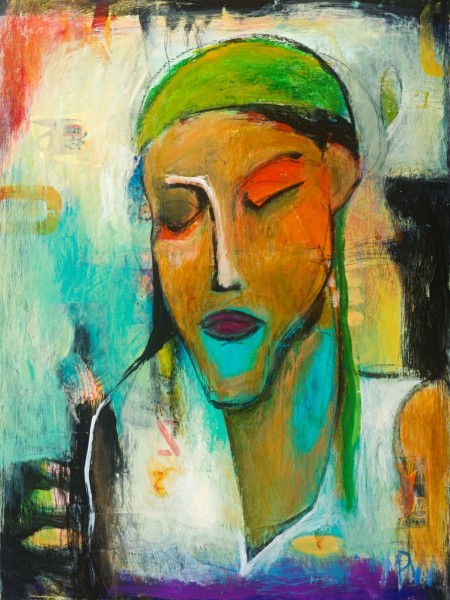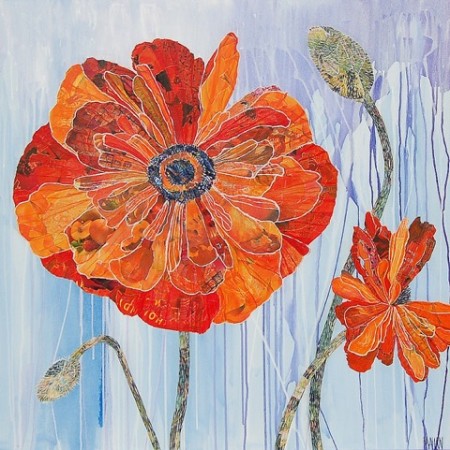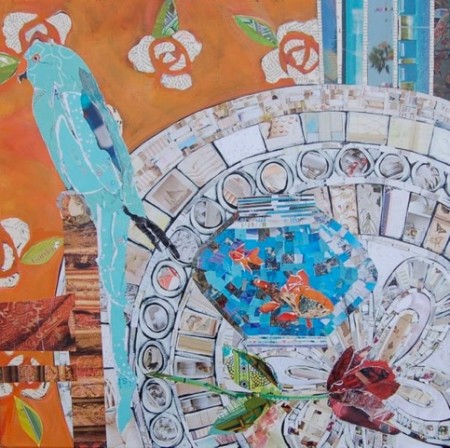From the moment you ascend the staircase at the YWCA Women’s Art Gallery to see “Last Splash of Color,” you are struck by a sense of harmony. This is due in part to similarities in the color palettes used by Susan Mahan, Paula Wiggins, and Ursula Brenner, three highly-skilled, well-established Cincinnati artists. But color alone does not account for the way the work of these women seems to belong together. In different ways, their work expresses pleasure in what a painter can do with color, lines, shapes, and subjects on canvas. Nowhere is this shared joy in being a painter more evident than a grouping found down a corridor leading off the main gallery. Ursula Brenner’s large “California II,” a beautiful abstract in which horizontal bars of color are separated by louvered white lines that admit light and air into the painting, is surrounded by six of Susan Mahon’s small, witty paintings of bud vases, each containing a single flower. This is more than a successful arrangement of art. The way the works play off each other is entrancing.
A large portrait, “Urban Island” presides over the main room of the gallery. It is one of only three portraits, all by Paula Wiggins, in a show of abstracts and still lifes. With its vivid lines, unexpected colors, and closed eyes, this portrait conveys both contemplative removal from everyday distractions and inner resourcefulness, qualities that could be attributed to all three artists. Wiggins has a number of abstracts in the show; the strongest, “Further Along,” demonstrates her characteristic flat matte surfaces, compositions in which whimsical line drawings are scattered on fields of color, and use of distinctive hues: blues and purples and greens. Some of her abstracts, like “Game of Chance,” hint at a narrative through the inclusion of small surprises, in this case a devil and skull and crossbones. Applied objects—a crucifix and a skeleton—appear in a large abstract, “The Immortals.” These objects and the title of the painting bring to mind the struggle between death and resurrection, doubt and belief. Wiggins’s unresolved compositions suggest a chaotic world, but her colors, always a balance of warm and cool, leave the viewer in a state of tranquility, even in the midst of confusion.
 Ursula Brenner is a more structured painter. A horizontal line runs across many of her paintings. The entire painting can be based on lines, as in the two “California” paintings and “Stripes,” a bold encaustic that draws the eye even from across the room with its bright color and heavily applied paint. In her abstracts, which seem to originate in a natural setting that is abstracted into shape and color, the horizontal line is more subtle and appears in the top quadrant of the canvas. In “Grays,” one of her strongest works in the show, the line suggests a horizon. The bright open space above is separated from a submerged, more mysterious space below. There the vivid colors merge into a wash of luminous pale gray at the center of the painting. The viewer’s eye is drawn to the spot, which suggests an opening to a realm beyond the painting. Despite the drama found in the painting, it conveys feelings, not of danger, but of transcendence. “Abstracted Land with Water,” another painting divided by a horizontal line, reveals in its title how close Brenner’s abstracts come to being landscapes. “Architecture,” another encaustic, resembles an aerial map of a carefully delineated world below.
Ursula Brenner is a more structured painter. A horizontal line runs across many of her paintings. The entire painting can be based on lines, as in the two “California” paintings and “Stripes,” a bold encaustic that draws the eye even from across the room with its bright color and heavily applied paint. In her abstracts, which seem to originate in a natural setting that is abstracted into shape and color, the horizontal line is more subtle and appears in the top quadrant of the canvas. In “Grays,” one of her strongest works in the show, the line suggests a horizon. The bright open space above is separated from a submerged, more mysterious space below. There the vivid colors merge into a wash of luminous pale gray at the center of the painting. The viewer’s eye is drawn to the spot, which suggests an opening to a realm beyond the painting. Despite the drama found in the painting, it conveys feelings, not of danger, but of transcendence. “Abstracted Land with Water,” another painting divided by a horizontal line, reveals in its title how close Brenner’s abstracts come to being landscapes. “Architecture,” another encaustic, resembles an aerial map of a carefully delineated world below.
 Color is the primary element in the paintings of Paula Wiggins and Ursula Brenner. With Susan Mahan drawing, as much as color, plays a critical role in her technique. At first glance, her impressionistic paintings appear merely pretty. The large floral paintings, “Some Days Are Better than Others” and “Solitude” are in danger of looking like Marimekko fabrics until you get close enough to notice her considerable skill as a painter. From any distance, “Rainy Day Poppies,” rich red flowers against pale blue, is a beautifully rendered and striking painting. Small messages are hidden inside many of her flowers, a strategy that forces the viewer to get close and pay more attention. Mahan’s drawing has a deliberately primitive quality, with thick outlines and distorted perspectives. “Betty Immediately Regretted Leaving the Cage Door Open,” a mosaic-like depiction of classic painterly subjects—a wing chair, a bird, an oriental carpet—is reminiscent of Matisse, clearly an influence on this artist. “After the Carnival Left Town” is a wonderfully off-kilter composition containing a fishbowl, a bird, and an inlaid table top set against a background of elaborate wallpaper. The glossy surface of Mahon’s paintings enhances their rich colors. These paintings are indeed pretty, but they are also spare, humorous, and sophisticated.
Color is the primary element in the paintings of Paula Wiggins and Ursula Brenner. With Susan Mahan drawing, as much as color, plays a critical role in her technique. At first glance, her impressionistic paintings appear merely pretty. The large floral paintings, “Some Days Are Better than Others” and “Solitude” are in danger of looking like Marimekko fabrics until you get close enough to notice her considerable skill as a painter. From any distance, “Rainy Day Poppies,” rich red flowers against pale blue, is a beautifully rendered and striking painting. Small messages are hidden inside many of her flowers, a strategy that forces the viewer to get close and pay more attention. Mahan’s drawing has a deliberately primitive quality, with thick outlines and distorted perspectives. “Betty Immediately Regretted Leaving the Cage Door Open,” a mosaic-like depiction of classic painterly subjects—a wing chair, a bird, an oriental carpet—is reminiscent of Matisse, clearly an influence on this artist. “After the Carnival Left Town” is a wonderfully off-kilter composition containing a fishbowl, a bird, and an inlaid table top set against a background of elaborate wallpaper. The glossy surface of Mahon’s paintings enhances their rich colors. These paintings are indeed pretty, but they are also spare, humorous, and sophisticated.
Appropriately, there is not a lot of black in “Last Splash of Color.” These three artists are not interested in the darker realms of experience, which is not to say they avoid mystery, deep emotions, or complexity. When it does appear, black is used sparingly, employed to highlight the wonderful spectrum of colors that go together so effectively in this show.
“Last Splash of Color” continues at the YWCA Women’s Art Gallery through January 15, 2016.
–Daniel Burr






